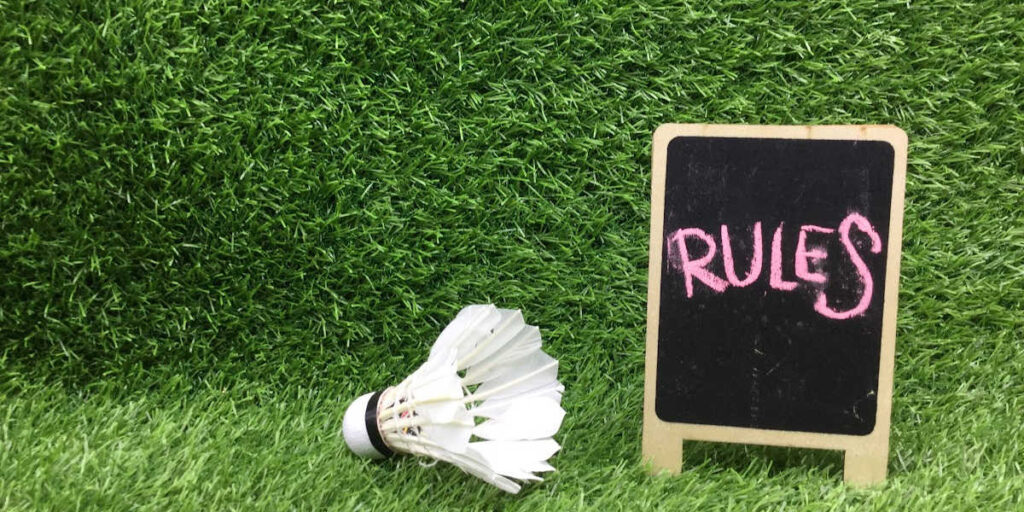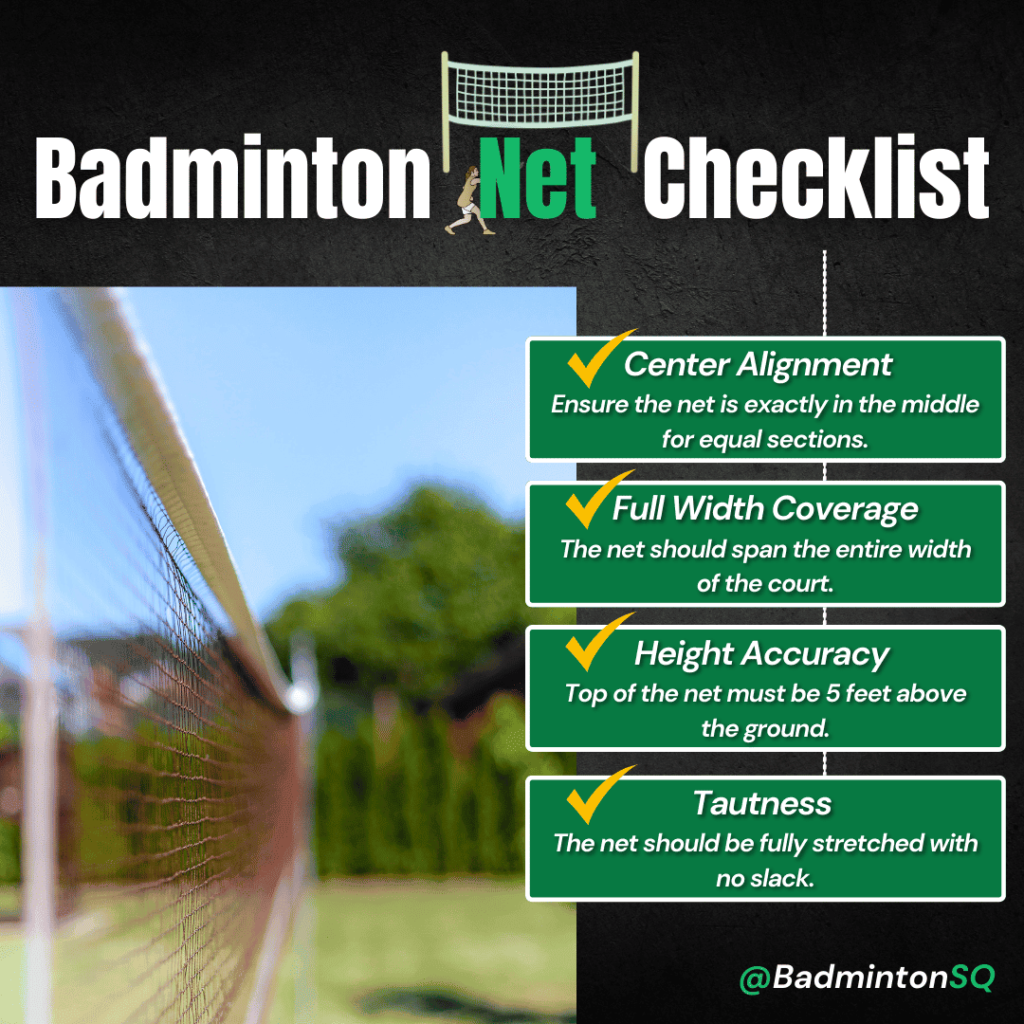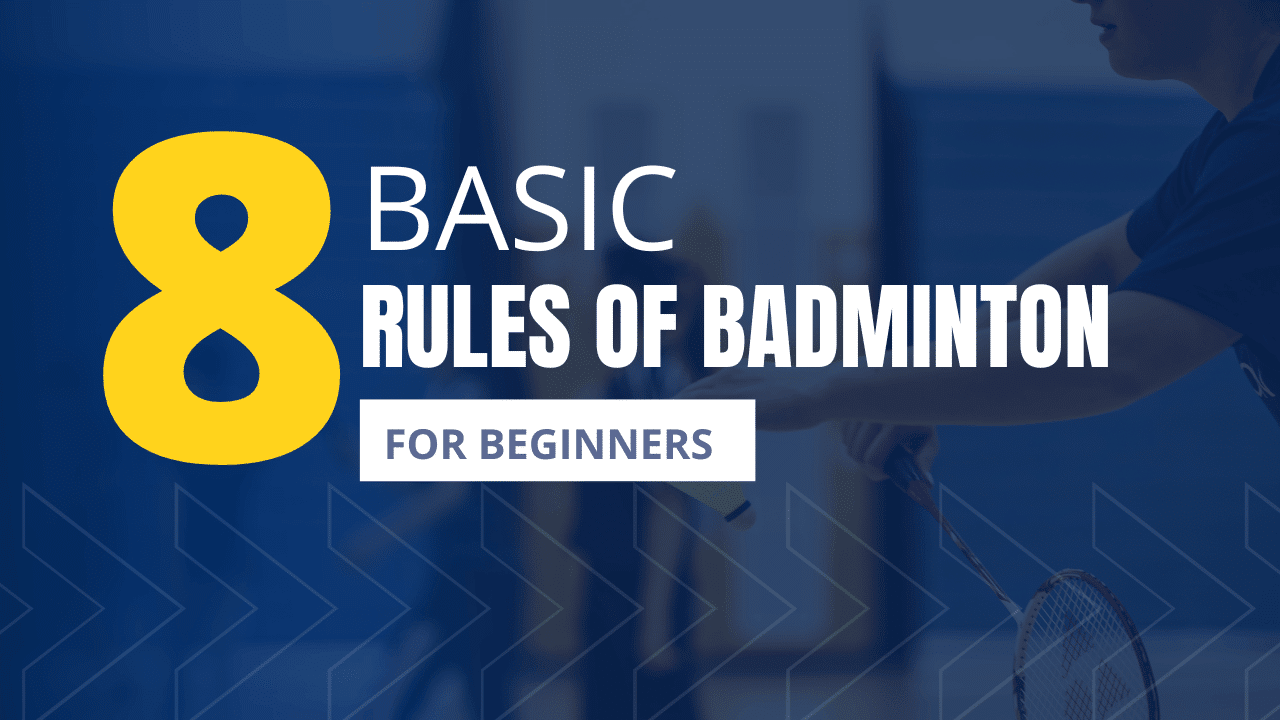Just like every other sport, badminton has a specific set of rules that you must know. Many advanced players have trouble recalling the basics. So, treat this article as a guide to brush up on the basic rules of badminton.

In this article, we are going to talk about the basic rules of:
- Types of Badminton
- The badminton court
- Toss
- Service
- Receiving
- Scoring System
- Faults
- Lets
All of these aspects have specific rules you need to follow in a professional badminton game. Let’s take a look at them one by one, starting with the types of badminton.
Types of Badminton
There are basically two types of badminton:
- Singles
- Doubles
Badminton Singles
In badminton singles, there’s only one player on each side of the court. There are men’s singles and women’s singles. A man and a woman cannot play against each other in any singles game.
Here you may read details about Badminton Singles
Badminton Doubles
In badminton doubles, there are two players on each side of the court respectively. There are men’s doubles and women’s doubles. This means all the players competing should either be mentioned or women.
There’s also a third sub-type known as mixed doubles. Here, there’s one man and one woman on each side of the court. A team of women cannot compete against a team of men.
Here you may read details about Badminton Doubles
The Badminton Court
In a professional setting, badminton is always played indoors. Even though many people play badminton outdoors in their backyard or on the beach, that’s not allowed as per the rule. The reason is simply the weight of the shuttlecock – it is too light and can be easily swayed even with the smallest blow of the wind. A badminton court is always placed indoors to avoid that.
Now, let’s see what the actual orientation of the court is.
Badminton Court Orientation
The badminton court is rectangular in shape with more length and less width. The length of the court is 44 feet. However, width changes according to the type of badminton.
- A singles badminton court is 17 feet wide.
- A doubles badminton court is 20 feet wide.
While drawing the boundaries on a badminton court, both the singles and doubles lines are drawn with the same color on the same court.
It is easy to get confused between the lines, but here’s a golden rule – the outer lines on your left and right are boundaries for doubles, and the inner lines on your left and right are boundaries for singles.
There’s also a single line in the middle of the court extending from the back of the court to the net. This is the center line to mark the two halves of the court – one for each player in a doubles game.
Net placement
A net is placed in the middle of the court. You must check that:
- The net is placed exactly in the middle of the field so both sections have equal space.
- The net covers the entire width of the field.
- The top of the net must be 5 feet high from the ground.
- The net must be completely stretched and shouldn’t slack anywhere.

Toss
A toss is flipped before every game to decide who will initiate the game. The player/team winning the toss gets to decide if they want to serve or receive. The losing player/team can choose the side of the court they want to play from.
Service
A badminton service is always made diagonally, irrespective of the type of badminton. So, if you are serving from the left side of the court, it must land on the right side of your opponent’s court.
The service is always done by standing inside the service boxes drawn on each side of the court. Which service box you stand in depends on your score.
- If you have an even score, you serve from the right side of the court.
- If you have an odd score, you serve from the left side of the court.
While you serve, the shuttlecock must be below your waist when it makes contact with the racquet. You are only allowed to hit the shuttle once, and it must directly enter your opponent’s court without bouncing or hitting the net.
Receiving
While receiving, you must be standing diagonally from your opponent when the service starts. After that, you can receive it from any part of the court.
In badminton doubles, you cannot hit the shuttlecock aimed at your partner’s side of the court. You cannot touch the racquet with your partner during the entire game.
Scoring System
In badminton, there are ways in which a player can score:
- When the opponent misses a shot.
- When the opponent commits a fault.
- When the opponent hits the shuttlecock outside the marked court. (If you hit the shuttle that was clearly going outside the court, you do not get a point.)
In every basketball game, a total of three sets are played. You have to win two out of the three sets to win the game. Courts are switched after every set to avoid partiality. And in the last set, courts are switched after one of the players scores 11 points.
For instance, if you were playing from the court near the door, your opponent would get that court after the end of the set. You have to occupy the court from which your opponent was playing.
You get a 60-second break to make this switch. While making this switch, you have to move around the net. You cannot bend below the net to enter the opposite court; it is considered as a fault.
Faults
What is considered a major fault according to badminton rules?
The following are the major faults in badminton that every beginner must know, If you commit one of these faults, your opponent gets an extra point.
1. Contact fault
If a shuttlecock comes in contact with your body or clothing, the ground, your partner (in case of doubles), or the net after service, it is a fault.
2. Net faults
- If your racquet touches the net at any point in the game, it is a fault.
- Hitting the shuttlecock underneath the net is considered a fault.
3. Service faults
- If you do not hit the shuttlecock in a single underarm motion, it is a fault.
- During a serv, the shuttlecock must be below your waist when it first comes in contact with the racquet.
- The service shouldn’t land outside the court.
- Service must be delivered only from the dedicated service box. You cannot even step on the service line.
4. Receiver faults
- If you are receiving, then you must not move before the service is delivered.
- You must not hit the shuttlecock over the net before it enters your side of the court.
5. Other faults
- If you double-hit the shuttlecock at any time in the game, it’s a fault.
- In a doubles game, your partner shouldn’t hit the shuttlecock if you have already hit it.
- Your feet must always be inside the boundary except when you are changing the court.
Lets
A “let” in badminton is a situation where the rally is stopped and replayed without any points awarded and no change in serving positions.
Here are the common scenarios where a let might occur:
Service Let: If the serve hits the net and goes to the opponent’s side, it’s called a service let. The serve is replayed without any points being awarded.
Equipment Malfunction: If a player’s equipment, such as a racket, shoes, etc., breaks or gets damaged during a rally, it may be declared a let.
External Interference: If something outside of players’ control, such as a shuttle from another court or a spectator, interferes with the rally, a let may be called.
Umpire’s Decision: In certain situations where the umpire deems it necessary to stop the game, they can call a let. The entire rally is replayed.

Conclusion
This covers the basic rules of badminton that every beginner, as well as an experienced player, must know. Failing to follow these rules is considered a fault. Your opponent benefits in the form of a point for every fault you commit. So, instead of giving free points to your opponent, learn these basic rules.
Do you know How to Become a Better Badminton Player
Frequently Asked Questions
What is an illegal serve in badminton?
An illegal serve in badminton is when
– You hit the shuttlecock more than once during service.
– You play a tennis-style serve.
– You move the racquet back and forth multiple times before hitting the shuttlecock.
What happens if the shuttlecock hits a player?
If a shuttlecock hits a player, it is considered a fault. If it hits the receiving player, a point is given to the serving player.
Can your racket go over the net in badminton?
Yes, If you don’t touch the net first and hit the shuttle on the side, then your racket will go over the net.
Why is a yellow card given in badminton?
A yellow card is given to a player in badminton if they are found committing a fault deliberately.
What are zero points in badminton called?
Zero points in badminton is called love.
Is it badminton racket or racquet?
The correct spelling is “badminton racket”. The word “racquet”, is commonly used for other racquet-based sports such as tennis and squash.
